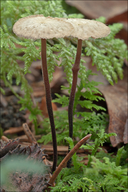date of photo Oct 15, 2013
latitude 46.36030 longitude 13.70293
View on Google Maps.
location
Lower Trenta valley, between villages Soča and Trenta, southeast of 'Na melu' place, East Julian Alps (Posočje, Slovenia)notes Slo.: iglična sehlevka - Micromphale perforans (Hoffm.) Gray (1821), syn.: Marasmiellus perforans (Hoffmann 1783) Fries 1821, Marasmius abietis (Batsch 1783) Quelet 1888, Gymnopus perforans (Hoffm.) Antonín & Noordel. (2008) - Habitat: under Picea abies growing on an abandoned pasture already partly overgrown with individual trees, locally flat terrain, calcareous ground, in full shade, partly protected from direct rain by tree canopy, average precipitations ~ 3.000 mm/year, average temperature 7-9 C, elevation 600 m (1.950 feet), alpine phytogeographical region. - Substratum: fallen off needles of Picea abies in moos layer. - Comments: This is a common species in Trenta valley. When the time, temperature and humidity are appropriate these tiny mushrooms sometimes explode in an unimaginable number. Hundreds upon hundreds grow almost under every Picea abies tree in the mixed forest. Pity, they are not larger and edible ;-) - Growing in a large group under the canopy of a large Picea abies tree. Pilei diameter from 5 to 8 (10) mm; stipe thin, about 0.6 mm in diameter and max 3 cm tall; smell unpleasant, taste mild, specific but I don't know on what; SP abundant, whitish-crème, oac900. Measured spores seem too large when compared to data from literature, however, even the literature written by prominent authors states surprisingly different dimensions in spite of the fact that this is a common species. - Spores smooth. Measured dimensions: 7,9 [9 ; 9,3] 10,3 x 2,6 [3,9 ; 4,4] 5,7 microns, Q = 1,8 [2,2 ; 2,3] 2,7; N = 41; C = 95%. Me = 9.1 x 4.2 microns; Qe = 2,2. Olympus CH20 NEA 100x/1.25, magnification 1.000 x, oil, in water, congo red. AmScope MA500 digital camera. - Herbarium: Mycotheca and lichen herbarium (LJU-Li) of Slovenian Forestry Institute, Večna pot 2, Ljubljana, Index Herbariorum LJF - Ref.: (1) S. Buczacki, Collins Fungi Guide, Collins (2012), p 198. (2) R.M. Daehncke, 1200 Pilze in Farbfotos, AT Verlag (2009), p 330.(3) G.J. Krieglsteiner (Hrsg.), Die Grosspilze Baden-Württembergs, Band 3. Ulmer (2001), p 334. (4) R. Lueder, Grundkurs Pilzbestimmung, Quelle & Meyer (2008), p 232.(5) M.Bon, Parey's Buch der Pilze, Kosmos (2005), p 176.camera Nikon D700/Nikkor Micro 105mm/f2.8
contributor's ID # Bot_761/2013_DSC8668 photo category: Fungi - fungi
|
